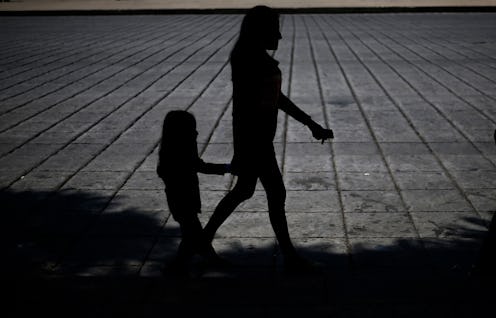News
13 Sex Trafficking Statistics That Put The Worldwide Problem Into Perspective

Millions of women, men, and children around the world become victims of human trafficking each year, according to the United Nations. In an attempt to not only raise awareness about the issue of human trafficking but end the practice, the United Nations has used the end of July to mark World Day against Trafficking in Persons since 2013. But the practice of human trafficking won't be eradicated without everyone's help, including yours. Start by educating yourself on this World Day Against Trafficking in Persons with these 13 alarming sex trafficking statistics.
While human trafficking is defined by the Department of Homeland Security as a "modern-day form of slavery involving the illegal trade of people for exploitation or commercial gain," it can take many forms. Lured by false promises of a good job, educational opportunities, a stable conflict-free environment or even a loving romantic relationship, victims of human trafficking are then pushed into forced labor or begging, sexual exploitation, and domestic servitude.
Over the years, human trafficking has, unfortunately, become a global multi-billion-dollar enterprise that affects nearly every single country, according to the United Nations. And sex trafficking alone is among the world's fastest growing criminal industries.
Here are 13 statistics you need to know about sex trafficking
1The Trafficking Of Women & Children Is The World's Fastest Growing Crime
A number of organizations, including the Department of Defense have characterized human trafficking as the world's fastest growing crime. And reports show traffickers are reaping huge profits off the crime. According to an Equality Now fact sheet, the sex trafficking industry pulls in an estimated $99 billion each year.
2There Are An Estimated 24.9 Million People Trapped In Forced Labor Via Human Trafficking Worldwide
In September 2017, the International Labor Organization (ILO) estimated that 24.9 million men, women, and children were victims of human trafficking around the globe.
3The Majority Of Victims Are Women & Girls
While trafficking victims can be individuals of both genders, the majority of victims are women and girls. According to data from the UN, 51 percent of victims are women while another 20 percent are girls, accounting for 71 percent of victims.
4More Than 50 Percent Of Trafficking Victims Are Sexually Exploited
According to the United Nations Office on Drugs and Crime's 2016 Global Report on Trafficking in Persons, 54 percent of all trafficking victims in 2014 were trafficked for the purpose of sexual exploitation.
5In Fact, The Most Common Form Of Human Trafficking Is Sexual Exploitation
According to the United Nations, the most common form of human trafficking is trafficking for sexual exploitation.
6While The Majority Of Sex Trafficking Victims Are Female, Men Are Also Victims
Between 2012 and 2014, the United Nations detected 23,000 victims of sex trafficking. While the majority of those victims were female, men were also reported as victims. According to the UN, males reported as trafficked for sexual exploitation between 2012 and 2014 were "concentrated in Western and Southern Europe and the Americas."
7Traffickers Can Be Women, Too
According to the UN Office on Drugs and Crime, women make up a relatively large share of convicted traffickers when compared to most other crimes. In fact the UN claimed court cases have shown that while the majority of trafficking victims are women and girls, women are also "commonly involved in the trafficking of women and girls, in particular." Specifically, data showed that women are often used to recruit other women into trafficking.
8Sex Trafficking Is Happening In The US
The United States isn't immune to incidents of sex trafficking. In fact, the Urban Institute examined what they called "the underground sex economy," which includes sex trafficking, of eight U.S. cities in 2014.
It estimated that those economies ranged from $39.9 million in Denver, Colorado, to $290 million in Atlanta, Georgia.
9The Number Of Human Trafficking Victims In The US Could Be On The Rise
Although there are no official numbers or estimates regarding the number of human trafficking victims in the United States, Polaris, a nonprofit working to combat modern-day slavery and human trafficking, said they saw a 13 percent jump in identified cases from 2016 to 2017.
The organization believes the overall number of human trafficking victims in the United States is somewhere in the hundreds of thousands.
10One Hotline Received More Than 6,000 Reports Of Sex Trafficking In 2017
Polaris' National Human Trafficking Hotline said it was notified about 6,244 cases of sex trafficking in 2017 alone.
11A Majority Of Those Sex Trafficking Cases Concerned Escort Services
According to the National Human Trafficking Hotline, the majority — 1,572 cases to be exact — of reports regarding sex trafficking cases pertained to escort services. Another 508 cases concerned residential situations while 329 were related to outdoor solicitation.
12You Can Be A Victim Of Sex & Labor Trafficking
According to Human Trafficking Search, a human trafficking victim can be a victim of both sexual exploitation and forced labor. The most common forms of sex and labor trafficking are, according to Polaris, illicit massage businesses, bars, strip clubs, or cantinas, and other more broadly defined "illicit activities."
13Prosecution Rates Remain Alarmingly Low
Despite the high number of estimated victims and cases worldwide, prosecution rates in cases of human trafficking appear low. According to the State Department's 2017 Trafficking in Persons (TIP) report, there were globally only 14,894 trafficking prosecutions and 9,071 convictions in 2016.